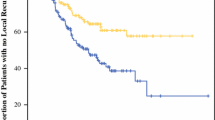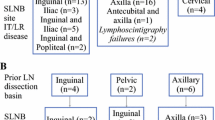Abstract
Introduction
Histological evidence of primary tumor regression (RG) is observed in 35% or fewer patients with cutaneous melanoma. Some advocate a lower threshold for sentinel lymph node (SLN) biopsy when RG is present.
Methods
We identified 1,349 patients presenting to our center with clinically localized cutaneous melanoma between 1995 and 2004. Of these, 344 demonstrated histological RG in their primary melanoma. A retrospective analysis of their medical records was performed to obtain clinical and pathological information.
Results
The median Breslow depth for the 344 patients with RG was 1.1 mm versus 1.5 mm for 1,005 patients with no regression (NRG) (P < 0.005). SLN biopsy was performed in 64% of patients with RG and 72% without. Positive SLN was more common in those with NRG than in those with RG (18% vs 10%, P = 0.005). Only one RG patient with thin melanoma (≤1 mm, Clark IV) had a positive SLN. When stratified by Breslow depth, patients with RG had lower rates of SLN positivity in all groups (≤1.0mm, >1.0 and ≤2.0mm, >2 and ≤4 mm, and >4.0 mm). Recurrence was more common in patients with NRG (21% vs 12%; P < 0.005). Both local and systemic recurrence occurred more commonly in patients with NRG (4% vs 1%, P = 0.002 and 8% vs 3%, P < 0.005, respectively)
Conclusions
The presence of histological RG in a primary melanoma predicts neither SLN positivity when stratified by Breslow depth nor increased risk of recurrence when compared with melanomas with NRG.





Similar content being viewed by others
References
American Cancer Society. Cancer Facts and Figures 2006. 4. 2006. Atlanta, GA, American Cancer Society
Kalady MF, White RR, Johnson JL, Tyler DS, Seigler HF. Thin melanomas: predictive lethal characteristics from a 30-year clinical experience. Ann Surg 2003; 238:528–35
Naruns PL, Nizze JA, Cochran AJ, Lee MB, Morton DL. Recurrence potential of thin melanomas. Cancer 1986; 57(3):545–8
Slingluff CL Jr., Vollmer RT, Reintgen DS, Seigler HF. Lethal “thin” malignant melanoma. Identifying patients at risk. Ann Surg 1988; 208:150–61
Berman DM. Lack of agreement on predictors for metastasizing thin melanomas. Histopathology 2006; 48:217–9
Blessing K, McLaren KM. Histological regression in primary cutaneous melanoma: recognition, prevalence and significance. Histopathology 1992; 20:315–22
Guitart J, Lowe L, Piepkorn M, et al. Histological characteristics of metastasizing thin melanomas: a case-control study of 43 cases. Arch Dermatol 2002; 138:603–8
Clark WH Jr., Elder DE, Guerry D, et al. Model predicting survival in stage I melanoma based on tumor progression. J Natl Cancer Inst 1989; 81:1893–904
Blessing K, McLaren KM, McLean A, Davidson P. Thin malignant melanomas (less than 1.5 mm) with metastasis: a histological study and survival analysis. Histopathology 1990; 17:389–95
Park KG, Blessing K, McLaren KM, Watson AC. A study of thin (<1.5 mm) malignant melanomas with poor prognosis. Br J Plast Surg 1993; 46:607–10
Kelly JW, Sagebiel RW, Blois MS. Regression in malignant melanoma. A histologic feature without independent prognostic significance. Cancer 1985; 56:2287–91
Glass LF, Guffey JM, Schroer KR, Reintgen D. Histopathologic study of recurrent Clark level II melanomas. Semin Surg Oncol 1993; 9:202–7
Brogelli L, Reali UM, Moretti S, Urso C. The prognostic significance of histologic regression in cutaneous melanoma. Melanoma Res 1992; 2:87–91
McGovern VJ, Shaw HM, Milton GW. Prognosis in patients with thin malignant melanoma: influence of regression. Histopathology 1983; 7:673–80
Czarnetzki BM, Denter M, Brocker EB, et al. Clinical features of superficial spreading melanomas with zones of regression. J Cancer Res Clin Oncol 1984; 107:225–8
Tefany FJ, Barnetson RS, Halliday GM, et al. Immunocytochemical analysis of the cellular infiltrate in primary regressing and non-regressing malignant melanoma. J Invest Dermatol 1991; 97:197–202
Balch CM, Buzaid AC, Soong SJ, et al. Final version of the American Joint Committee on Cancer staging system for cutaneous melanoma. J Clin Oncol 2001; 19:3635–48
Cooper PH, Wanebo HJ, Hagar RW. Regression in thin malignant melanoma. Microscopic diagnosis and prognostic importance. Arch Dermatol 1985; 121:1127–31
Fontaine D, Parkhill W, Greer W, Walsh N. Partial regression of primary cutaneous melanoma: is there an association with sub-clinical sentinel lymph node metastasis? Am J Dermatopathol 2003; 25:371–6
Moretti S, Spallanzani A, Pinzi C, Prignano F, Fabbri P. Fibrosis in regressing melanoma versus nonfibrosis in halo nevus upon melanocyte disappearance: could it be related to a different cytokine microenvironment? J Cutan Pathol 2007; 34(4):301–8
Taran JM, Heenan PJ. Clinical and histologic features of level 2 cutaneous malignant melanoma associated with metastasis. Cancer 2001; 91:1822–5
Acknowledgment
The authors thank Ms. Liza Marsh for editorial assistance.
Author information
Authors and Affiliations
Corresponding author
Rights and permissions
About this article
Cite this article
Morris, K.T., Busam, K.J., Bero, S. et al. Primary Cutaneous Melanoma with Regression Does not Require a Lower Threshold for Sentinel Lymph Node Biopsy. Ann Surg Oncol 15, 316–322 (2008). https://doi.org/10.1245/s10434-007-9675-2
Received:
Revised:
Accepted:
Published:
Issue Date:
DOI: https://doi.org/10.1245/s10434-007-9675-2




